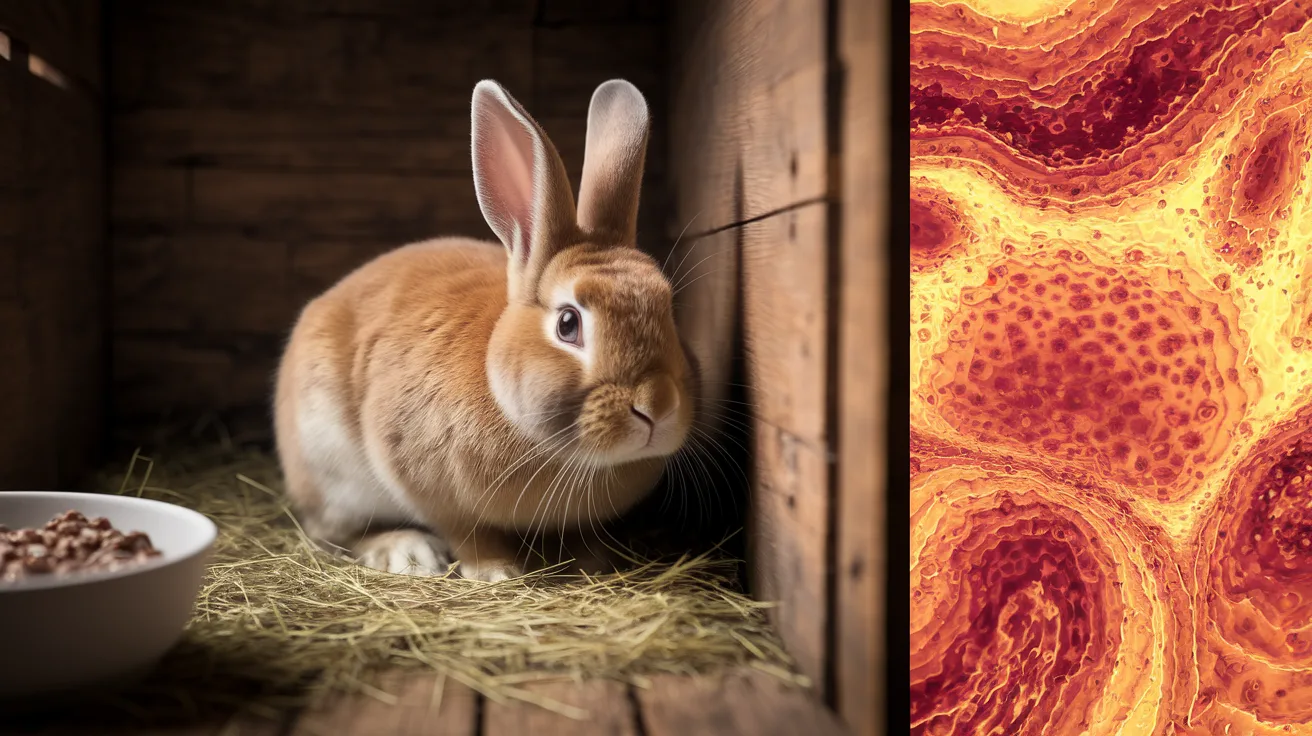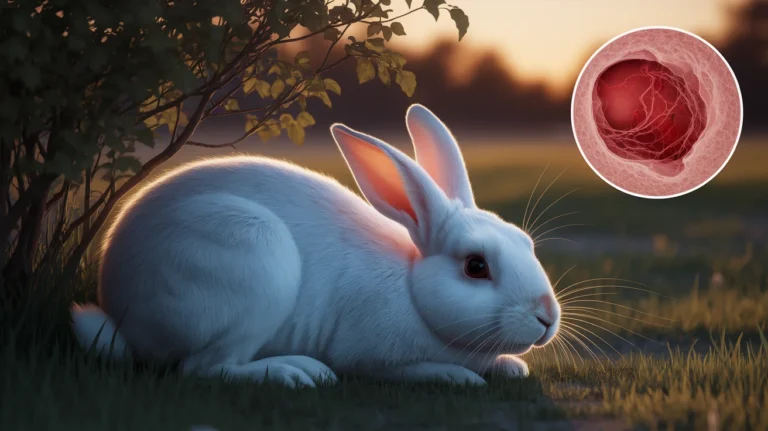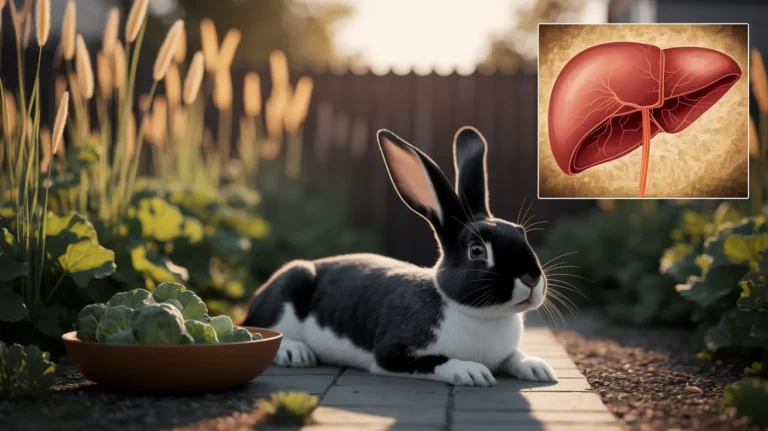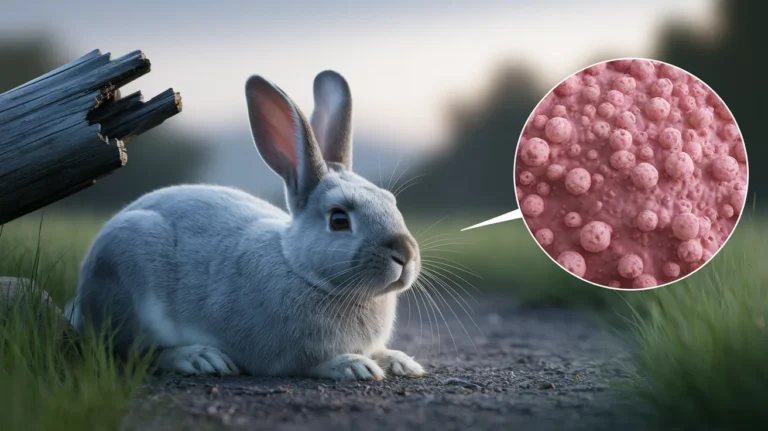Discover essential prevention tips and treatment options for myxomatosis in rabbits, a deadly viral disease affecting pet and wild rabbits worldwide. Learn to protect your furry friend!
Myxomatosis is a severe and often fatal viral disease that affects both wild and domestic rabbits. This devastating condition, caused by the myxoma virus, can spread rapidly through rabbit populations, causing significant suffering and high mortality rates. For rabbit owners and caretakers, understanding the nature of myxomatosis, recognizing its symptoms, and knowing how to prevent it are crucial aspects of responsible rabbit care. This comprehensive guide explores the causes, symptoms, prevention strategies, and treatment options for myxomatosis in rabbits, providing essential information to help protect your furry companions from this deadly disease.
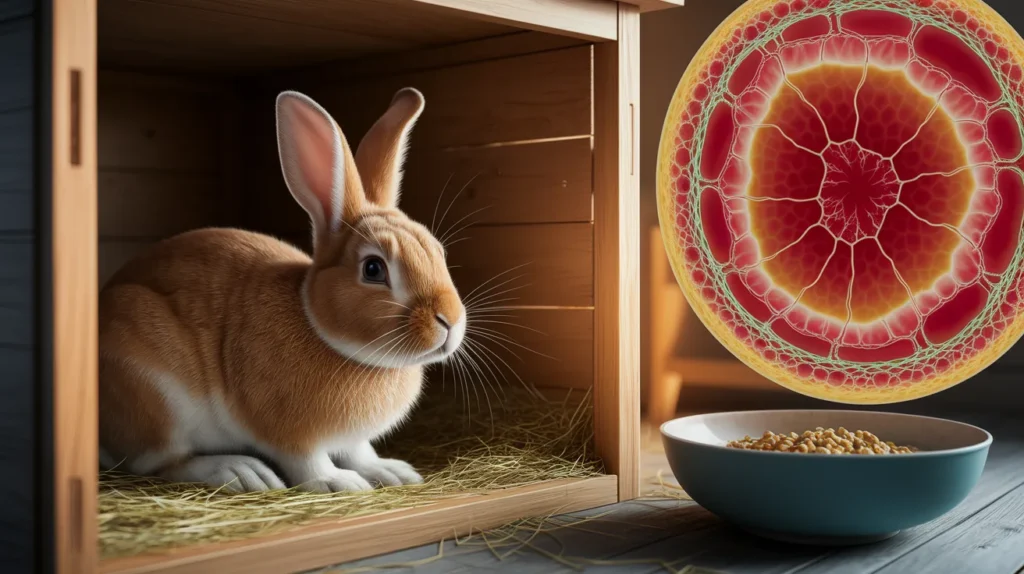
Table of Contents
What is Myxomatosis in Rabbits?
Myxomatosis is a highly contagious viral disease specific to rabbits, caused by the myxoma virus, a member of the poxvirus family. The disease was first observed in laboratory rabbits in Uruguay in the late 19th century and has since become a significant concern for rabbit populations worldwide.
History and Global Impact
The myxoma virus gained notoriety in the 1950s when it was deliberately introduced to Australia and Europe as a biological control method to manage the overpopulation of European rabbits. The virus was incredibly effective, initially killing up to 99% of infected rabbits in Australia. However, over time, both the virus and rabbit populations have evolved, resulting in varying degrees of resistance and virulence.
Today, myxomatosis remains endemic in many parts of the world, including Europe, Australia, and parts of North and South America. The disease continues to pose a significant threat to both wild rabbit populations and domestic pets.
How Myxomatosis Spreads
Understanding the transmission methods of myxomatosis is essential for effective prevention. The virus spreads through several key vectors:
- Biting insects: Fleas, mosquitoes, and biting flies are the primary vectors. They transmit the virus when they feed on an infected rabbit and then bite a healthy one.
- Direct contact: The virus can spread through direct contact between infected and non-infected rabbits, particularly through contact with discharge from the eyes, nose, or skin lesions.
- Contaminated objects: Food, water, cages, bedding, and other items can become contaminated with the virus and serve as sources of infection.
- Human transmission: Humans can inadvertently carry the virus on clothing, shoes, or hands from infected areas to healthy rabbits.
The myxoma virus can survive in the environment for extended periods, especially in cool, damp conditions, making thorough disinfection and preventive measures crucial.
Symptoms of Myxomatosis in Rabbits
Myxomatosis manifests through distinct clinical signs that typically develop within 5-14 days after infection. The disease progression and symptom severity can vary depending on the virus strain and the rabbit’s resistance level. Recognizing these symptoms early is vital for prompt intervention.
Early Signs
The initial symptoms of myxomatosis can be subtle and may include:
- Lethargy and decreased activity
- Reduced appetite or complete loss of interest in food
- Mild fever
- Slightly swollen eyelids or genitals
- Discharge from eyes or nose
These early signs might be easily mistaken for other common rabbit ailments, making vigilant observation essential.
Advanced Symptoms
As the disease progresses, more severe and characteristic symptoms appear:
- Severe swelling: Particularly noticeable around the head, face, ears, eyelids, lips, and genitals
- Eye conditions: Severe conjunctivitis, discharge, and eventual blindness
- Respiratory issues: Labored breathing, nasal discharge, and respiratory distress
- Skin nodules: Small, firm nodules or lesions developing on the body
- Mucosal inflammation: Swelling and inflammation of mucous membranes
- Anogenital swelling: Pronounced swelling around the anus and genitals
In the classic or “nodular” form of myxomatosis, rabbits develop significant facial swelling, giving them a characteristic “lion-headed” appearance, with swollen, closed eyes and distorted facial features.
Terminal Stage
In its final stages, myxomatosis typically leads to:
- Extreme weakness and prostration
- Difficulty breathing
- Elevated body temperature
- Secondary bacterial infections
- Eventual death, usually within 10-14 days after symptoms appear
The mortality rate for classical myxomatosis is extremely high, with most unvaccinated rabbits succumbing to the disease. The survival rate for rabbits with classical myxomatosis is less than 5%.
5 Essential Prevention Tips for Myxomatosis in Rabbits
Preventing myxomatosis is far more effective than treating it once infection occurs. Here are five comprehensive strategies to protect your rabbits:
1. Vaccination
Vaccination is the single most effective preventive measure against myxomatosis.
Vaccination Protocol:
- Initial vaccination for rabbits over 5 weeks of age
- Annual booster shots
- Some veterinarians recommend biannual vaccinations in high-risk areas
The myxomatosis vaccine is often combined with the Rabbit Hemorrhagic Disease Virus (RHDV) vaccine, providing protection against both deadly diseases in a single injection.
Efficacy and Considerations:
- Vaccines provide significant protection but may not prevent all cases
- Vaccinated rabbits that do contract myxomatosis typically experience milder symptoms
- Some countries or regions may have different vaccination protocols or available vaccines
According to a study published in the Journal of Veterinary Medicine, vaccination can reduce the risk of myxomatosis by up to 98% in domestic rabbits.
2. Insect Control
Since biting insects are primary vectors for myxomatosis, comprehensive insect control is essential:
Environmental Management:
- Keep grass and vegetation around rabbit housing short
- Remove standing water where mosquitoes can breed
- Install fine-mesh screens on windows and ventilation openings
- Consider using mosquito nets over outdoor hutches during high-risk seasons
Direct Protection:
- Use rabbit-safe insect repellents (consult with a veterinarian)
- Apply veterinarian-approved flea treatments regularly
- Check rabbits daily for signs of insect bites or infestations
Indoor Housing:
- Consider keeping rabbits indoors, especially during peak insect seasons
- Maintain clean living conditions to minimize insect attraction
A survey of rabbit owners in the UK found that those implementing comprehensive insect control measures experienced 73% fewer cases of myxomatosis compared to those with minimal insect management.
3. Proper Housing and Quarantine
Creating a safe living environment is crucial for preventing myxomatosis:
Housing Design:
- Ensure hutches are raised off the ground
- Use solid floors rather than wire mesh to prevent contact with ground-dwelling insects
- Provide adequate ventilation while maintaining protection from the elements
- Use hutch covers at night and during bad weather
Quarantine Procedures:
- Isolate new rabbits for at least 14-21 days before introducing them to existing rabbits
- Quarantine any rabbits showing signs of illness
- Use separate feeding equipment and bedding for quarantined animals
- Wash hands and change clothes between handling quarantined and healthy rabbits
Cleaning and Disinfection:
- Disinfect hutches and equipment regularly with rabbit-safe disinfectants
- Remove uneaten food and soiled bedding daily
- Deep clean housing monthly or more frequently if needed
Research indicates that proper housing and quarantine procedures can reduce disease transmission by up to 85% in rabbit colonies.
4. Limit Exposure to Wild Rabbits
Preventing contact between domestic and wild rabbits significantly reduces myxomatosis risk:
Physical Barriers:
- Use double fencing around outdoor enclosures to prevent direct contact
- Install underground barriers to prevent wild rabbits from digging into runs
- Use solid rather than wire fencing where possible to prevent nose-to-nose contact
Exercise Area Safety:
- Avoid exercise runs in areas frequented by wild rabbits
- Supervise outdoor playtime
- Create dedicated, enclosed exercise areas rather than allowing free roaming
Environmental Awareness:
- Be aware of local wild rabbit populations and disease outbreaks
- Adjust preventive measures based on regional risk levels
- Consider seasonal adjustments to housing and exercise routines
A study from the European Rabbit Research Foundation found that domestic rabbits with no exposure to wild populations had a 90% lower incidence of myxomatosis compared to those with potential wild rabbit contact.
5. Hygiene and Biosecurity Measures
Implementing strict hygiene protocols helps prevent the introduction and spread of the virus:
Personal Hygiene:
- Wash hands thoroughly before and after handling rabbits
- Change clothes and footwear when moving between different rabbit groups
- Use dedicated clothing when visiting other rabbit facilities or wild areas
Visitor Management:
- Limit visitors’ contact with your rabbits
- Ask visitors if they have been in contact with other rabbits recently
- Provide hand sanitizer or handwashing facilities for anyone handling your rabbits
Feed and Bedding Safety:
- Store food and bedding in sealed, insect-proof containers
- Source hay and bedding from reliable suppliers
- Avoid collecting wild plants for rabbit consumption
Environmental Control:
- Regularly disinfect all surfaces and equipment
- Use footbaths with appropriate disinfectants at entry points to rabbit housing
- Implement a systematic cleaning schedule and maintain cleaning records
According to veterinary research, comprehensive biosecurity measures can reduce disease introduction by up to 80% in domestic rabbit environments.
Treatment Options for Myxomatosis in Rabbits
Despite the severity of myxomatosis, treatment options do exist, though they are primarily supportive rather than curative. Early intervention and comprehensive care are essential for improving survival chances.
Supportive Care
The cornerstone of myxomatosis treatment is providing supportive care to help rabbits fight the infection:
Fluid Therapy:
- Subcutaneous or intravenous fluids to prevent dehydration
- Electrolyte solutions to maintain proper balance
Nutritional Support:
- Force-feeding if necessary, using critical care formulas
- High-quality, easily digestible foods
- Vitamin supplements to support immune function
Comfort Measures:
- Soft, clean bedding
- Regular cleaning of discharge from eyes, nose, and genitals
- Maintaining optimal environmental temperature
- Minimizing stress and handling
Eye Care:
- Gentle cleaning of affected eyes
- Application of prescribed eye drops or ointments
- Protection from bright light
Medical Interventions
While there is no specific antiviral treatment for the myxoma virus, several medical interventions can help manage symptoms and prevent secondary infections:
Antibiotics:
- Broad-spectrum antibiotics to prevent or treat secondary bacterial infections
- Typically administered orally or by injection
- Common choices include enrofloxacin, trimethoprim-sulfa, or penicillin derivatives
Anti-inflammatory Medications:
- Non-steroidal anti-inflammatory drugs (NSAIDs) to reduce inflammation and fever
- Corticosteroids are generally avoided as they may further suppress the immune system
Specific Symptom Management:
- Respiratory support, potentially including oxygen therapy
- Antihistamines to reduce swelling in some cases
- Topical treatments for skin lesions
Immune Support:
- Immune-stimulating supplements
- Probiotics to maintain gut health during antibiotic treatment
Prognosis and Recovery
The prognosis for rabbits with myxomatosis varies significantly based on several factors:
Factors Affecting Survival:
- Virus strain and virulence
- Rabbit’s age, general health, and vaccination status
- Time elapsed before treatment initiation
- Quality and intensity of supportive care
- Presence of secondary infections
Recovery Timeline:
- Acute phase typically lasts 10-14 days
- If a rabbit survives beyond two weeks, chances of recovery improve
- Full recovery may take 4-8 weeks or longer
- Some rabbits may develop chronic health issues following recovery
Long-term Considerations:
- Recovered rabbits may develop immunity to the specific strain they contracted
- Permanent scarring or eye damage may occur
- Some rabbits may require ongoing care for residual symptoms
According to veterinary statistics, with intensive supportive care, survival rates for the less virulent forms of myxomatosis can reach 30-50%, though the classical form still has a very high mortality rate even with treatment.
Alternative and Complementary Approaches
In addition to conventional treatments, some rabbit owners and veterinarians explore complementary approaches to support recovery:
Herbal Remedies:
- Echinacea for immune support
- Chamomile for calming effects
- Calendula for skin healing
Homeopathic Treatments:
- Thuja for swelling reduction
- Belladonna for fever and inflammation
- Arsenicum album for respiratory symptoms
Nutritional Therapy:
- Antioxidant-rich foods
- Vitamin C supplementation
- Omega-3 fatty acids for inflammation reduction
It’s important to note that while some rabbit owners report positive results with these approaches, scientific evidence for their efficacy is limited. Always consult with a rabbit-savvy veterinarian before implementing any alternative treatments, and never delay conventional medical care in favor of alternative options.
Special Considerations for Different Rabbit Populations
The approach to myxomatosis prevention and treatment may vary depending on the rabbit population in question:
Indoor Pet Rabbits
Indoor rabbits generally face lower risk but still require preventive measures:
- Vaccination remains essential
- Screen windows and doors to prevent insect entry
- Implement strict hygiene protocols for humans moving between indoor and outdoor environments
- Be cautious about introducing new plants, hay, or bedding that could harbor insects
Outdoor Pet Rabbits
Rabbits kept outdoors face significantly higher risk and require enhanced protection:
- Consider double vaccination protocols in high-risk areas
- Use insect-proof housing with fine mesh screens
- Implement seasonal housing adjustments based on local insect populations
- Consider bringing rabbits indoors during high-risk periods
Breeding Facilities
Breeding operations face unique challenges in myxomatosis prevention:
- Implement strict biosecurity measures between breeding groups
- Develop comprehensive vaccination protocols, including for young rabbits
- Consider regular testing for early detection
- Create detailed response plans for potential outbreaks
Show Rabbits
Rabbits that attend shows or competitions require additional precautions:
- Ensure vaccinations are up-to-date before any shows
- Quarantine returning rabbits for at least two weeks
- Use separate equipment and clothing for show rabbits
- Avoid direct contact with other rabbits at shows where possible
Recommended Pet Products on Amazon
For rabbit owners looking to enhance their myxomatosis prevention strategies, these products may be helpful:
- Premium Rabbit Hutch Cover – Provides protection from insects and weather while allowing proper ventilation
- Veterinary-Approved Rabbit-Safe Insect Repellent – Helps keep biting insects away from rabbit housing areas
- Fine Mesh Screening Kit – For reinforcing hutches and runs against insect intrusion
- Complete Rabbit First Aid Kit – Includes essential supplies for emergency care and treatment support
Frequently Asked Questions about Myxomatosis in Rabbits
Can humans catch myxomatosis from infected rabbits?
No, myxomatosis is specific to rabbits and cannot infect humans. However, humans can inadvertently carry the virus on clothing or hands from infected to healthy rabbits, so proper hygiene measures are still important when handling rabbits.
How effective is the myxomatosis vaccine?
The myxomatosis vaccine is highly effective, reducing infection risk by approximately 98% in most cases. Vaccinated rabbits that do contract the disease typically experience milder symptoms and have a much higher survival rate. However, no vaccine provides 100% protection, so additional preventive measures remain important.
Can indoor rabbits get myxomatosis?
Yes, indoor rabbits can contract myxomatosis, though their risk is significantly lower than outdoor rabbits. The virus can be brought indoors on clothing, shoes, bedding, or food, or via insects that enter the home. Vaccination is recommended even for exclusively indoor rabbits.
Is myxomatosis always fatal?
While myxomatosis has a very high mortality rate (often exceeding 95% in unvaccinated rabbits with the classical form), it is not always fatal. Factors affecting survival include the virus strain, the rabbit’s health and vaccination status, and the quality of supportive care provided. Some milder strains have lower mortality rates, and even with severe strains, a small percentage of rabbits may recover with intensive supportive care.
How long can the myxoma virus survive in the environment?
The myxoma virus can survive for extended periods outside a host under favorable conditions. In cool, damp environments, the virus may remain viable for several months. In direct sunlight or dry conditions, survival time decreases significantly, typically to a few days or weeks. This environmental persistence makes thorough disinfection essential in affected areas.
Can wild rabbits be vaccinated against myxomatosis?
Mass vaccination of wild rabbit populations is generally not practical or feasible. Conservation efforts for endangered rabbit species sometimes include vaccination programs for specific populations, but this approach is limited in scope. Control of myxomatosis in wild populations typically focuses on habitat management and natural selection for resistant individuals.
How often should pet rabbits be vaccinated against myxomatosis?
Most veterinarians recommend annual vaccination against myxomatosis. However, in high-risk areas or during outbreak periods, some veterinarians advise biannual vaccination (every six months) for enhanced protection. The specific vaccination schedule should be determined in consultation with a rabbit-savvy veterinarian based on local risk factors.
The Global Impact of Myxomatosis
Understanding the broader impact of myxomatosis helps contextualize its significance for pet rabbit owners:
Ecological Impact
Myxomatosis has had profound effects on wild rabbit populations worldwide:
- Dramatic population declines in affected areas
- Disruption of ecosystems where rabbits play key roles
- Impacts on predator species that depend on rabbits as prey
- Changes in vegetation patterns due to reduced grazing pressure
Conservation Concerns
For some endangered rabbit species, myxomatosis poses a significant conservation challenge:
- The Iberian rabbit, essential to Mediterranean ecosystems, has suffered severe population declines
- Endangered predators like the Iberian lynx have been affected by rabbit scarcity
- Conservation programs increasingly include disease management strategies
Evolution and Adaptation
The relationship between rabbits and the myxoma virus represents one of the best-documented examples of host-pathogen coevolution:
- Over decades, rabbit populations have developed varying degrees of resistance
- The virus has evolved to maintain optimal virulence
- This evolutionary “arms race” continues to shape both rabbit and virus populations
Call-to-Action
Protecting your rabbits from myxomatosis requires ongoing vigilance and education. For more expert recommendations on rabbit care, disease prevention, and treatment options, visit BlithePet for comprehensive guides and resources. Our team of veterinary experts and experienced rabbit caregivers provides up-to-date information to help keep your furry companions healthy and happy.
Conclusion
Myxomatosis remains one of the most significant health threats facing domestic and wild rabbits worldwide. Its high mortality rate and challenging treatment make prevention the cornerstone of management. Through a combination of vaccination, insect control, proper housing, limited exposure to wild rabbits, and strict hygiene practices, rabbit owners can significantly reduce the risk of this devastating disease.
For those unfortunate cases where infection occurs, early recognition of symptoms and prompt, intensive supportive care provide the best chance for recovery. While treatment options remain limited, advances in veterinary medicine continue to improve outcomes for some affected rabbits.
Understanding myxomatosis—its transmission, symptoms, and management—is an essential aspect of responsible rabbit ownership. By implementing comprehensive preventive strategies and staying informed about local disease patterns, rabbit caregivers can help protect their beloved pets from this deadly virus.
Share your experiences with rabbit care and disease prevention in the comments below, and help build our community of knowledgeable, caring rabbit owners.

